Posted By PIMA
When it’s time to replace a roof, most owners choose roofing materials based on performance qualities like longevity and weather resistance. But a well-designed roof can also shine in another performance area: energy efficiency.
Energy efficiency is important to many owners with concerns ranging from climate impacts like building carbon footprints to the costs and reliability of energy resources. Since approximately 25 percent of heat loss in an uninsulated building occurs through the roof, choosing materials that add insulative power can add significant energy savings. For commercial and low-slope roof applications, adding layers of rigid foam insulation to the roofing system can deliver exceptional R-value without a lot of bulk.
An article last month from the Energy News Network details initiatives in Warren, Minnesota and Arnsberg, Germany to use thermal imaging in evaluating building heat loss to help owners determine the best energy efficiency opportunities.
The program was conceived after municipal leaders from Warren and Arnsberg met through the Climate-Smart Municipalities program sponsored by the University of Minnesota’s Institute on the Environment which paired five cities in Minnesota with similar cities in Germany. Arnsberg had been using remote-piloted aircraft to collect thermal images of building heat loss. Leaders in Warren decided to try using drones to get more detailed information.
Piggybacking off each other’s ideas, the two cities are innovating the practical applications of these thermal images in directing energy efficiency efforts to the places that will have the greatest impact. Their research provides further evidence that reroofing with energy-efficient materials can decrease building heat loss and lead to reduced energy consumption.
Tags: building envelope buildings continuous insulation Efficiency energy efficiency insulation Polyiso





